
The British Power Boat Company was a British manufacturer of motor boats from 1927 to 1946, particularly racing boats and later military patrol boats in Hythe, Hampshire.

The British Power Boat Company was a British manufacturer of motor boats from 1927 to 1946, particularly racing boats and later military patrol boats in Hythe, Hampshire.
The company was formed on 30 September 1927 when Hubert Scott-Paine bought and renamed the Hythe Shipyard with the intention of transforming it into one of the most modern mass production boat building yards in the country. Together with his chief designer, Fred Cooper, the company produced the 26-foot single step hydroplane racing boat Miss England I. [1] Fred Cooper later left, and Hubert Scott-Paine designed Miss Britain III.
From 1930 the British Power Boat Company supplied seaplane tenders to the Air Ministry, commencing with RAF200, a 37-footer. The trials of this and other boats was carried out by T. E. Shaw (T. E. Lawrence) on behalf of the Royal Air Force, and he and Scott-Paine worked together over the next few years. These tenders were powered by twin 100bhp Meadows petrol engines giving a maximum speed of 29 knots (some of the later ones were fitted with Perkins S6M diesels).
The company marketed its own modified Napier Sea Lion engines under the name "Power" Marine Engines. [2]
On 3 August 1931 the factory burnt to the ground, but was rapidly rebuilt as the most modern and efficient boatyard in Britain. Motor torpedo boats with a hard chine were designed, built, and increasingly sold to the British Admiralty. Armoured target boats were also built for the RAF, proving very successful and cost-effective, together with tenders for Imperial Airways flying boats, and admirals' barges.

In 1939, due to the difficulties in obtaining British engines, Scott-Paine took PT-9 to the US to enable Elco to mass-produce PT boats using Packard motors.

During World War II the British Power Boat Company built large numbers of motor torpedo boats, high-speed motor launches, and motor gun boats (previously known as Motor Anti-Submarine Boats [3] ), being credited with saving the lives of over 13,000 service personnel.
One of their welders during WW2 was artist Sybil Andrews, who also made some paintings of the boats under construction.
All unfinished contracts were cancelled at the cessation of hostilities, and the British Power Boat Company closed in 1946.
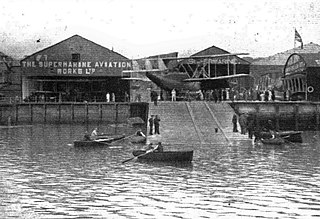
Supermarine was a British aircraft manufacturer. It is most famous for producing the Spitfire fighter plane during World War II. It also built a range of seaplanes and flying boats, winning the Schneider Trophy for seaplanes with three wins in a row in 1927, 1929 and 1931. After the war, the company produced a series of jet fighters.

A torpedo boat is a relatively small and fast naval ship designed to carry torpedoes into battle. The first designs were steam-powered craft dedicated to ramming enemy ships with explosive spar torpedoes. Later evolutions launched variants of self-propelled Whitehead torpedoes.

A PT boat was a motor torpedo boat used by the United States Navy in World War II. It was small, fast, and inexpensive to build, valued for its maneuverability and speed but hampered at the beginning of the war by ineffective torpedoes, limited armament, and comparatively fragile construction that limited some of the variants to coastal waters. In the US Navy they were organized in Motor Torpedo Boat Squadrons (MTBRONs).
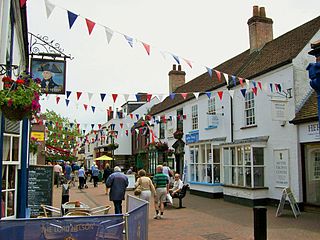
Hythe is a town in Hampshire, England. It is located by the shore of Southampton Water, and has a ferry service connecting it to Southampton. Hythe has a shopping area, a pier, and a marina for yachts.

A motor torpedo boat is a fast torpedo boat, especially of the mid 20th century. The motor in the designation originally referred to their use of petrol engines, typically marinised aircraft engines or their derivatives, which distinguished them from other naval craft of the era, including other torpedo boats, that used steam turbines or reciprocating steam engines. Later, diesel-powered torpedo boats appeared, in turn or retroactively referred to as "motor torpedo boats" for their internal combustion engines, as distinct from steam powered reciprocating or turbine propulsion.

The Type Two HSL was a 63 ft high-speed launch craft made by British Power Boat Company (BPBC). The craft were used during the Second World War for air-sea rescue operations to save Allied aircrew from the sea. The Type Two superseded the 64 ft HSL, and was itself replaced by the Type Three 68 ft "Hants and Dorset" also built by the BPBC. The Type Two was nicknamed the "Whaleback" due to the distinctive curve to its deck and humped cabin.
Henry Meadows, usually known simply as Meadows, of Wolverhampton, England, were major suppliers of engines and transmissions to the smaller companies in the British motor industry. Founded in 1920 in Park Lane, Wolverhampton, as a car gearbox maker, they expanded into petrol engines in 1922 and in the 1930s built a large factory in Fallings Park, Wolverhampton.

Nathanael Greene Herreshoff was an American naval architect, mechanical engineer, and yacht design innovator. He produced a succession of undefeated America's Cup defenders between 1893 and 1920.

The motor gunboat (MGB) was a small, high-speed British military vessel of the Second World War, which was armed with a mix of guns, in contrast to the physically similar motor torpedo boat (MTB), whose main offensive weapon were torpedoes. The small size of the MGBs, and their high speed, made them difficult targets for German E-boats, though, like their opponents, they were limited by heavy weather, because they did not provide a stable-enough platform to aim the guns. The large number of guns required a relatively large crew, numbering as high as thirty men on the largest boats.
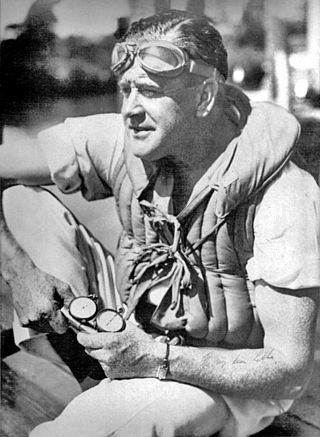
Hubert Scott-Paine was a British aircraft and boat designer, record-breaking power boat racer, entrepreneur, inventor, and sponsor of the winning entry in the 1922 Schneider Trophy.

Miss Britain III is a racing power boat designed and built by Hubert Scott-Paine.
Canadian Power Boat Company was a manufacturer of motor torpedo boats and similar craft in Canada during World War II.
Vosper & Company, often referred to simply as Vospers, was a British shipbuilding company based in Portsmouth, England.

USS Hilo (AGP-2) was a converted yacht that saw service as a motor torpedo boat tender in the United States Navy during World War II. It was originally the yacht Caroline built for Eldridge R. Johnson and launched 18 July 1931. Caroline was at the time the second largest yacht and largest American built Diesel yacht. It was built with a laboratory as well as palatial quarters and was loaned and equipped by Johnson for the Johnson-Smithsonian Deep-Sea Expedition of 1933 that explored the Puerto Rico Trench. The yacht was sold in 1938 to William B. Leeds and renamed Moana replacing an earlier Leeds yacht of the same name.

The Electric Launch Company, later renamed Elco Motor Yachts ("Elco"), is an American boat building and electric motor company that has operated from 1893 to 1949 and from 1987 to the present.
Huckins Yacht Corporation is one of the oldest boat builders in the United States. The company is located on the Ortega River in Jacksonville, Florida, and is run by its third-generation owners, Cindy and Buddy Purcell. Huckins manufactures custom yachts ranging from 40 to 90 feet that combine classic design and traditional workmanship with modern technology and amenities. It has built a total of 457 yachts during its 80 years of operation, crafting vessels one at a time.
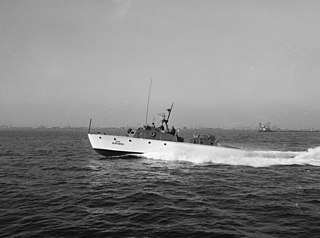
Crash Rescue Boat is a name used in the United States to describe military high-speed offshore rescue boats, similar in size and performance to motor torpedo boats, used to rescue pilots and aircrews of crashed aircraft. During World War II these rescue boats, armed with light anti-aircraft guns for self-defense, saw extensive service with the British Royal Air Force (RAF) and United States Army Air Forces (USAAF).
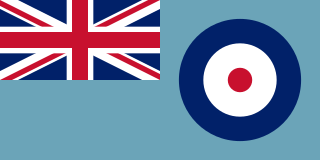
The Marine Branch (1918–1986) was a branch of the Royal Air Force (RAF) which operated watercraft in support of RAF operations. Just days after the creation of the RAF itself, the Marine Craft Section (MCS) was created with the transfer of Royal Naval Air Service (RNAS) vessels and personnel to the new service. Originally tasked with the support of RNAS, and later RAF, seaplanes, Marine Craft Section was to achieve its greatest size during the Second World War, and achieved fame for its role in air-sea rescue operations. After the war MCS was granted full branch status on 11 December 1947; however, post-war the role of the new branch became greatly reduced with the end of the British Empire, the withdrawal of flying boats from service, and the increasing use of helicopters in air-sea rescue. The branch was disestablished on 8 January 1986.

Crash boats, at the time known as "aircraft rescue boats" or "air-sea rescue boats", were United States high speed boats built to rescue the crew of downed Allied aircraft during World War II. US boats came from the observation of British experience with high-speed launches (HSL) by the Royal Air Force Marine Branch during the Battle of Britain.

Motor Torpedo Boat Squadron One was a World War II United States Navy PT boat squadron based at Naval Base Hawaii's Pearl Harbor PT Boat Base on 7 December 1941 during the Attack on Pearl Harbor. It was commanded by Lieutenant Lt. Comdr. William C. Specht and made up of 12 PT boats. After Pearl Harbor, MTBRon 1 was sent to Midway Atoll and took part in the Battle of Midway. MTBRon 1 was then sent to take part in the Aleutian campaign. MTBRon 1 was commissioned 24 July 1940 and decommissioned 9 February 1945.
{{cite web}}: CS1 maint: archived copy as title (link)